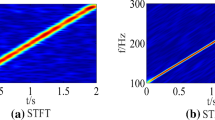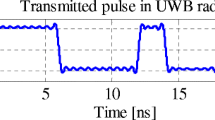Abstract
A classical problem in signal processing is accurate estimation of fundamental frequency/periodicity of periodic signals at low SNR. Typically, researchers address the estimation problem, assuming that the signal environment is a sum of sinusoids in white Gaussian noise. If the signals and noise are pulsed, the situation is much more complex since normal FFT based methods result in spectra which are sums of harmonic structures. Sorting radar signals can be especially difficult since there may be many pulsed signals present in a low SNR impulsive noise environment. In this paper, a method equivalent to integration along a hyperbola on the Wigner distribution is presented. This transform, which is closely related to both the Fourier transform and the correlation function, has the property that a periodic signal produces an expected non-zero complex-valued bulge at only the fundamental. The phase, magnitude and position of the correlation bulge are sufficient to characterize the time-domain pulse train. Finally, a simple super-resolution method is presented which may be used to refine the fundamental frequency/period estimate.
Similar content being viewed by others
References
J. D. Harris, and D. J. Nelson, “Glottal Pulse Alignment in Voiced Speech for Pitch Determination,” IEEEICASSP Conf., vol. 2, 1993, pp. 519–522.
S. M. Kay, “Statistically/Computationally Efficient Frequency Estimation,” IEEE–ICASSP Conf., vol. 5, 1988, pp. 2292–2295.
D. J. Nelson, “Special Purpose Correlation Functions,” Internal Technical Report, 1988.
D. J. Nelson, “Special Purpose Correlation Functions for Improved Signal Detection and Parameter Estimation,” IEEE–ICASSP Conf., 1993, pp. 519–522.
A. V. Oppenheim, and R. W. Schafer, Digital Signal Processing, Prentice Hall, 1975.
S. A. Tretter, “Estimating the Frequency of a Noisy Sinusoid ↖y Linear Regression,” IEEE Trans. on Info. Theory, 1985, pp. 832–835.
S. Umesh, and D. Nelson, “Computationally Efficient Estimation of Sinusoidal Frequency at Low SNR,” IEEE–ICASSP Conf., vol. 5, 1996, pp. 2797–2800.
Author information
Authors and Affiliations
Rights and permissions
About this article
Cite this article
Nelson, D. The “Harmonic” Rejecting Correlation Function. Multidimensional Systems and Signal Processing 9, 433–438 (1998). https://doi.org/10.1023/A:1008426911695
Issue Date:
DOI: https://doi.org/10.1023/A:1008426911695




